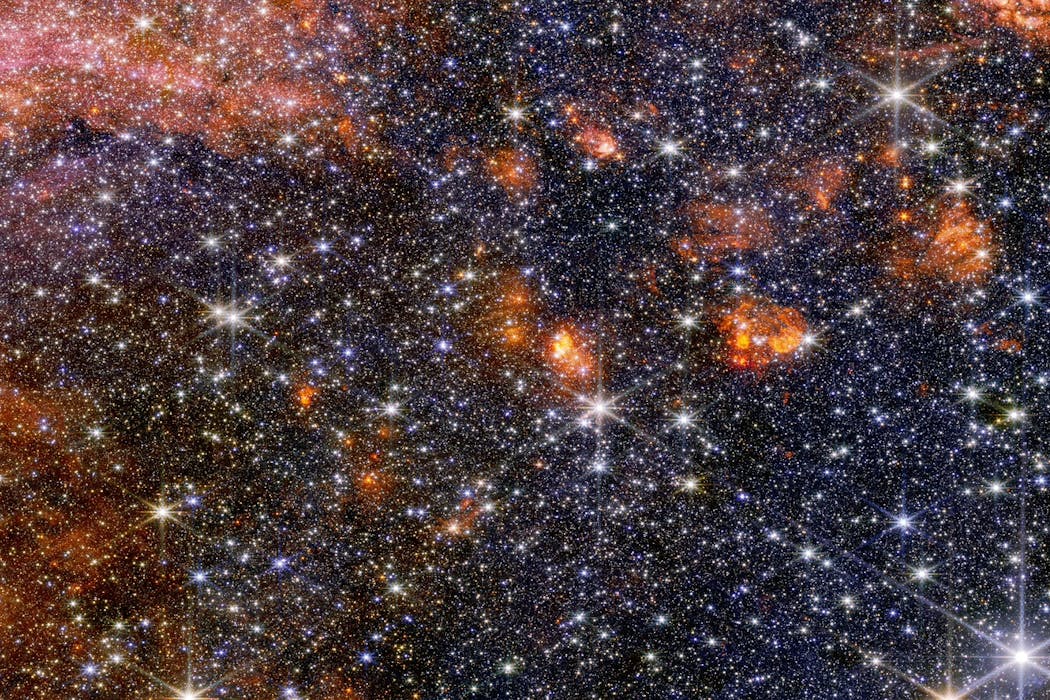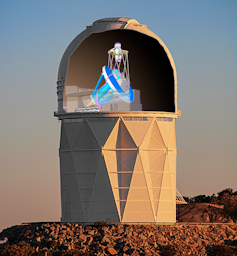
In 1980, Stephen Hawking gave his first lecture as Lucasian Professor at the University of Cambridge. The lecture was called “Is the end in sight for theoretical physics?”
Hawking, who later became my PhD supervisor, predicted that a theory of everything – uniting the clashing branches of general relativity, which describes the universe on large scales, and quantum mechanics, which rules the microcosmos of atoms and particles – might be discovered by the end of the 20th century.
Forty-five years later, there is still no definitive theory of everything. The main candidate is string theory, a framework that describes all forces and particles including gravity. String theory proposes that the building blocks of nature are not point-like particles like quarks (which make up particles in the atomic nucleus) but vibrating strings.
It suggests that, if we could look deep inside electrons, we would see loops of strings, vibrating just like those on a violin. Different patterns of string vibrations correspond to different particles.
String theory unifies all the forces of nature. Forces that seem very different, such as gravity and electricity, are deeply related to one another. The forces are linked by so-called dualities: the same underlying phenomena can be described in different ways.
The force of gravity is described in terms of geometry, shapes and positions. Other forces are described in terms of different mathematical concepts, including algebra and numbers.
The unification of forces hence implies profound relationships between branches of mathematics. Such relationships had previously been proposed by mathematicians, particularly by Robert Langlands, and string theory gives physical explanations for the relationships.
Although string theory could be the correct theory of everything, it is hard to test experimentally. The effects of string theory become visible at very small scales and very high energies.
Particle accelerators explore the internal structure of particles by colliding them and breaking them apart. However, even the biggest colliders at Cern in Switzerland don’t have enough energy to break particles down into strings.
Clues in the cosmos
How can we test string theory experimentally if we can’t reach high enough energies in colliders? The answer may lie in looking up to the skies.
The very early universe was dense and hot, and the primordial soup would have been made up of strings. We can see the history of the universe imprinted in current day observations, from surveys of galaxies through to measurements of the cosmic radiation that permeates all of space and is a leftover from the big bang.
In the early 20th century, American astronomer Edwin Hubble showed that the universe is expanding. Galaxies are moving further apart from each other.
At the end of that century, detailed observations of the expansion showed that it is in fact accelerating. Galaxies today are moving apart faster than they were a million years ago.
What is driving this acceleration? Gravity is an attractive force so it slows down the expansion of the universe. The acceleration of the universe is driven by a new kind of energy, which is spread throughout the whole of space. Scientists call this dark energy and it makes up about 70% of the energy of the universe.
We don’t know exactly what dark energy is. The most plausible explanation is that it is the inherent quantum energy of the universe. In the quantum world, particles can never just sit still, with no energy. There is always a little bit of quantum jitter and associated energy.
Atoms cooled down to absolute zero temperature still have energy because of their quantum motion. Dark energy could potentially be explained as being the underlying quantum energy of all the forces and particles in nature, including gravity.
Experiments are pinning down the properties of dark energy. Desi is an observatory based in Arizona, US, which is mapping out galaxies and quasars. The space based telescopes Euclid and Roman will measure the universe in unprecedented detail, mapping out the history of billions of galaxies over billions of years.

wikipedia, CC BY-SA
Recent results from Desi suggest that dark energy is changing in time in a way that is consistent with string theory models – although this is yet to be fully verified by further measurements.
This doesn’t prove string theory because string theory can produce a variety of different universes, with differing patterns of dark energy. However, the Desi results suggest that interpreting dark energy as quantum energy of strings may be on the right track. There are of course phenomena other than strings that could explain the change in dark energy.
Euclid and Roman will make very precise measurements and will be able to exclude many such theories of dark energy and some specific versions of string theory – helping to narrow down the bits theorists should focus on.
Another way to verify string theory may be via black holes. Once something falls inside a black hole, it cannot escape. Inside a black hole there are very strong forces and particles are torn apart. We still don’t understand exactly what happens inside a black hole, but string theory teaches us how a black hole retains information about what has fallen inside.
That’s because string theory assumes there is no “singularity” inside a black hole – a point of infinite density and gravity – but instead that the objects are spread out as balls of strings called fuzzballs.
Future, more precise, measurements of gravitational waves (ripples in the fabric of spacetime) will be looking for the subtle signals of the quantum behaviour inside black holes predicted by string theory. If black holes are fuzzballs, they should produce a different signal when they merge, lasting longer and containing echoes. What’s more, if extra dimensions exist, as string theory proposes, black holes may oscillate in different ways which we could also detect.
In addition to cosmological measurements, scientists can run thought experiments, just as Einstein did with his theories of relativity. String theory has led to new insights not just in mathematics but also in other areas of science. For example, string theory has proven to be useful in understanding how quantum systems can be used in computing.
I don’t think a complete understanding of a theory of everything is just around the corner, but in the 45 years since Hawking’s Lucasian lecture we have certainly learned a lot. And right now, things are looking up for string theory.
![]()
Marika Taylor currently receives funding from EPSRC, STFC, UK government deparments and the European Horizon programme.



